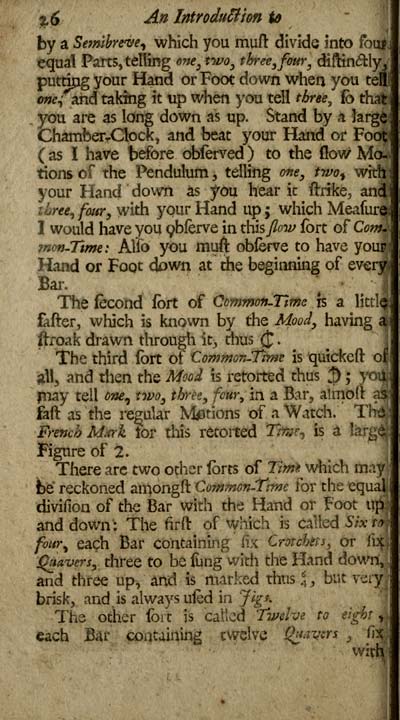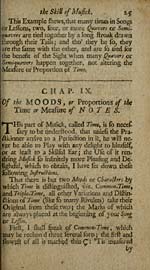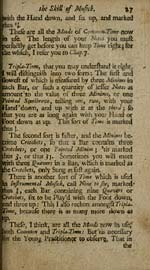Inglis Collection of printed music > Printed text > Introduction to the skill of musick, in three books
(50) Page 26
Download files
Complete book:
Individual page:
Thumbnail gallery: Grid view | List view

%6 An Introdutthn U
by a Semibrcve^ which you muft divide into fou|,
equal Parts, telling me, two, three, four, diftin&ly.
putting your Hand or Foot down when you ten
one; and taking it up when you tell three 1 fo that
you are as long down as up. Stand by a large
ChambeivClock, and beat your Hand or Foot
( as I have before obferved ) to the flow M*
tions of the Pendulum , telling one, two y with'
your Hand down as you hear it ftrike, an#
'.•«, four, with your Hand up ; which Meafur$
I would have you obferve in this flow fort of Com\
mon-Time: Alio you muft obferve to have youra
Hand or Foot down at die beginning of every*
Bar.
The fecond fort of Common-Time is a littlJi
fafter, which is known by the Mood, having a
ftroak drawn through it, thus (f .
The third fort of Common-Time is quickefr oj
all, and then the Mood is retorted thus 1) ; yotj]
Jtiay tell one, two, thrc., four, in a Bar, a!mo(r as
faff, as the regular Motions of a Watch. The
French Mxrk for this retoited Tine, Is a largS
Figure of 2.
There are two other forts of Time ^ which may;
be reckoned amongft Common-Ttmc for the equali
divifion of the Bar with the Hand or Foot urij
and down: The nrft of which is called Six m
four, each Bar containing fix Crotchta, or fix*
(Quavers, three to be fung with the Hand down,,
and three up, and is marked thus$, butverjj
brisk, and is always ufed in Jig*,
The other fort is called Twelve to <?
each Bar containing twelve ffeavtrs } fii
with
by a Semibrcve^ which you muft divide into fou|,
equal Parts, telling me, two, three, four, diftin&ly.
putting your Hand or Foot down when you ten
one; and taking it up when you tell three 1 fo that
you are as long down as up. Stand by a large
ChambeivClock, and beat your Hand or Foot
( as I have before obferved ) to the flow M*
tions of the Pendulum , telling one, two y with'
your Hand down as you hear it ftrike, an#
'.•«, four, with your Hand up ; which Meafur$
I would have you obferve in this flow fort of Com\
mon-Time: Alio you muft obferve to have youra
Hand or Foot down at die beginning of every*
Bar.
The fecond fort of Common-Time is a littlJi
fafter, which is known by the Mood, having a
ftroak drawn through it, thus (f .
The third fort of Common-Time is quickefr oj
all, and then the Mood is retorted thus 1) ; yotj]
Jtiay tell one, two, thrc., four, in a Bar, a!mo(r as
faff, as the regular Motions of a Watch. The
French Mxrk for this retoited Tine, Is a largS
Figure of 2.
There are two other forts of Time ^ which may;
be reckoned amongft Common-Ttmc for the equali
divifion of the Bar with the Hand or Foot urij
and down: The nrft of which is called Six m
four, each Bar containing fix Crotchta, or fix*
(Quavers, three to be fung with the Hand down,,
and three up, and is marked thus$, butverjj
brisk, and is always ufed in Jig*,
The other fort is called Twelve to <?
each Bar containing twelve ffeavtrs } fii
with
Set display mode to: Large image | Transcription
Images and transcriptions on this page, including medium image downloads, may be used under the Creative Commons Attribution 4.0 International Licence unless otherwise stated. ![]()
| Special collections of printed music > Inglis Collection of printed music > Printed text > Introduction to the skill of musick, in three books > (50) Page 26 |
|---|
| Permanent URL | https://digital.nls.uk/94573852 |
|---|
| Description | Scottish and English songs, military music and keyboard music of the 18th and 19th centuries. These items are from the collection of Alexander Wood Inglis of Glencorse (1854 to 1929). Also includes a few manuscripts, some treatises and other books on the subject. |
|---|
| Description | The Glen Collection and the Inglis Collection represent mainly 18th and 19th century Scottish music, including Scottish songs. The collections of Berlioz and Verdi collected by bibliographer Cecil Hopkinson contain contemporary and later editions of the works of the two composers Berlioz and Verdi. |
|---|

